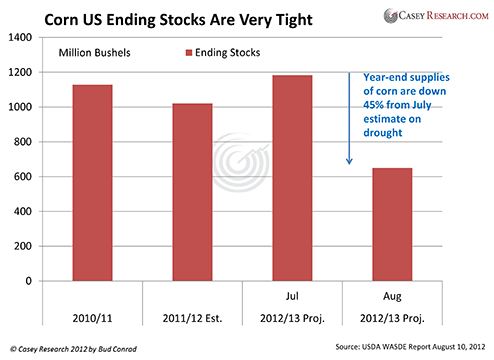Our news media have not given enough attention to the very serious heat problems of this summer's growing season for grains. The heat and drought have seriously damaged the corn crop during the early July period of tasseling. The price of corn at $8 per bushel is a new record high. Similarly, $9 per bushel of wheat and soybeans at $16 a bushel are a record high. Soybeans are in the middle of their crucial pod filling stages in August and are looking vulnerable. The decline in the quality of the corn crop over the growing season shows just how serious this year's drought has been.
One measure of the drought shows this year to be the worst since the dust bowl of 1934.
One of the biggest domestic uses for grains is feed for cattle, pigs and poultry. In this drought, some 70% of grazing land has also been damaged. The high grain prices mean that cattle farmers are losing money. To cut their losses, they liquidate their herds, driving meat prices down. For beef, there could be shortages three years from now when the new calves that aren't being bred now would be coming to market, driving prices up then.
40% of our corn crop is diverted to the very inefficient creation of ethanol for fuel to supplant part of our crude oil demand. Requests by farmers to cut the regulation requiring the use of ethanol have not had much effect. Ethanol processing plants require capital investment, so it is difficult to change the parameters that set up the plants after the investments have been made. But it makes little sense to have such a program that does relatively little to alleviate our petroleum demand in the face of the corn shortage.
One of the reasons that food prices have not risen as fast as other commodity prices until recently is that we have enjoyed massive productivity from the "green revolution" of using better fertilizers and genetically modified plants that can produce higher yields per acre. But in the last five years, these yield increases have been very small. Jeremy Grantham of GMO newsletter provides this graph, showing that the problem may be more long term than just this year.
It is debatable whether this is some kind of biological limit or just the result of a number of one-time weather events across the planet. I think that a combination of disruptive climate change and the limits of biological processes will restrict our ability to grow the increasing quantities of food that the increasing population expects. I think higher food prices are part of our future.
The US is the biggest exporter of grains in the world. With these higher prices, there will be political reverberations around the world. The Arab Spring was partly instigated by poor and underemployed people finding they could not afford food's rising cost. We can expect political problems ahead. This chart shows that political crises occur more frequently when food prices are high. The food price will go to new records once futures prices filter through the production process.
(Source: Paper by Marco Lagi, Karla Z. Bertrand and Yaneer Bar-Yam (2011),
The Food Crises and Political Instability in North Africa and the Middle East)
This morning's (August 10, 2012)USDA's World Agricultural Supply Demand confirmed the fears of drought damage. The chart below shows the projected stocks of corn expected at the end of the 2012/2013 crop year as being 45% less than they were predicted last month.
Food comprises 14.2% of our CPI index, with cereals only 1.2%, so the effect on consumers will be much weaker than the headline commodity price jumps, but food has a surprising correlation with other prices, like energy.
This weather event is signaling a change in the importance of agriculture and food in our economic system. Expect higher prices to stay with us, and expect price and escalation to continue. Higher inflation will affect interest rates too.











